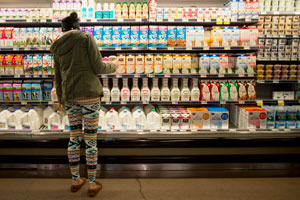Economic Growth Cools as American Consumers Temper Spending

The U.S. economy expanded at a slower pace in the fourth quarter as households tempered spending and businesses cut back on capital investment and adjusted inventories.
Gross domestic product rose at a 0.7% annualized rate in the three months ended in December after a 2% gain in the third quarter, Commerce Department figures showed Jan. 29. The advance was in line with the Bloomberg News survey median forecast of 0.8%.
Growth has downshifted as producers contend with slowing markets abroad, the negative effect on exports from a stronger dollar and plunging oil prices that have caused drilling firms to retrench. Consumers, enjoying the fruits of a robust labor market and cheaper fuel bills, will have to pick up the slack if growth is expected to get back on track.
“The economy perhaps isn’t quite as strong as we thought it was — there’s clearly some very weak spots, but there’s a solid foundation to growth,” said Nariman Behravesh, chief economist at IHS Inc. in Lexington, Massachusetts, who is the best forecaster of GDP over the past two years according to data compiled by Bloomberg. Even after the fourth-quarter slowdown, “the stars are aligned for consumer spending to return.”
Economists’ projections for GDP, the value of all goods and services produced, ranged from a 0.2% decline to a 1.7% increase. The Commerce Department’s estimate is the first of three for the quarter, with the other releases scheduled for February and March when more information becomes available.
GDP expanded 2.4% for a second straight year, led by the biggest gain in consumer spending in a decade. The economy got off to a rocky start in 2015, partly due to bad winter weather and a West Coast port workers dispute, before rebounding in the second quarter.
Growth moderated in the ensuing months as companies worked down bloated stockpiles and continued to battle weak exports markets.
The report showed household purchases rose at a 2.2% annualized pace in the fourth quarter, compared with a 3% rate in the previous period. Personal consumption added 1.46 percentage points to growth.
Final sales to domestic purchasers, or GDP excluding trade and inventories, climbed at an inflation-adjusted 1.6% annualized rate in the fourth quarter, compared with a 2.9% pace in the previous three months.
A pickup in household purchases will be needed to help the economy fight through the negative effects of the global slowdown and the rout in commodities that’s diminishing investment.
While businesses are struggling, American households have plenty of ammunition to assist the economy. Last year, after-tax income adjusted for inflation climbed 3.5%, the most since 2006, the Commerce Department’s report showed.
Consumer confidence levels have held in, powered by solid gains in the job market and low inflation. So far, households are looking beyond the recent volatility in the stock market.
Gasoline prices are still low, which gives households some room to improve spending in the first quarter. The average cost of a gallon of regular gasoline fell 13% in the final three months of last year and has slipped another 8.7% to $1.82 in the year through Jan. 27.
Weak global demand, combined with the plunge in oil prices, has led to cutbacks at some companies. Business investment decreased at a 1.8% annualized rate, the first drop since the third quarter of 2012 and compared with a 2.6% pace in the third quarter. Corporate spending on equipment fell at a 2.5% pace after 9.9%.
Fourth-quarter spending on structures retreated at a 5.3% rate, led by a 38.7% annualized decrease in mining and oil and gas well drilling rigs, after a slump of 7.2% in the previous three months. For all of last year, outlays for structures used in mining and to extract oil and gas plunged 35%, the most since 1986.
Business inventories in the fourth quarter subtracted 0.45 percentage point from growth after a 0.71 percentage point drag in the previous three months, the Commerce report showed.
Looking ahead, “it looks like inventories are in a better balance now,” said Michael Feroli, chief U.S. economist at JPMorgan Chase & Co. in New York.
Still, “the number one headwind for growth is foreign trade,” Feroli said. “The strength of the dollar and the weakness in global growth continued to hurt exporters.”
The trade deficit widened to $566.1 billion, shaving 0.47 percentage point from GDP growth last quarter. Trade has subtracted from GDP in four of the last five quarters.
Homebuilding was a bright spot in the GDP figures, increased an annualized 8.1% after an 8.2% in the third quarter.
Federal Reserve policymakers said Jan. 27 they are keeping close watch over financial and global developments, as they assess how much of a threat they pose to their economic outlook. The central bank last month raised interest rates for the first time in almost a decade, though deterioration in growth prospects may lead them to slow the pace of future hikes and make a move in March less likely.




